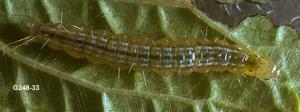|
False Celery Leaftier |
|
Contents |
This section contains information on identification of the false celery leaftier in peppermint. Adults of this insect closely resemble adults of the mint root borer. However, larvae of false celery leaftier feed only on mint leaves and do not bore in mint rhizomes. Adults of orange mint moth also may be present in mint fields at the same time as adults of mint root borer and false celery leaftier.
|



